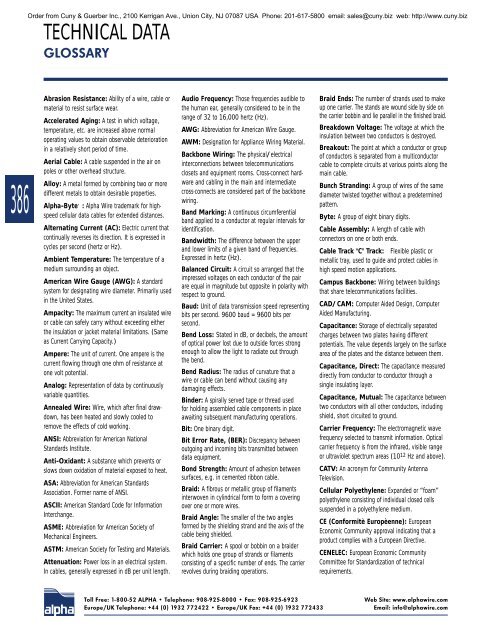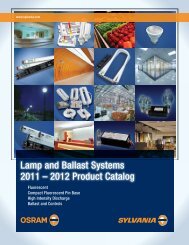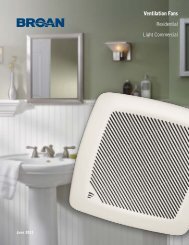Alpha Wire Company MASTER CATALOG - Cuny & Guerber, Inc.
Alpha Wire Company MASTER CATALOG - Cuny & Guerber, Inc.
Alpha Wire Company MASTER CATALOG - Cuny & Guerber, Inc.
Create successful ePaper yourself
Turn your PDF publications into a flip-book with our unique Google optimized e-Paper software.
386<br />
Order from <strong>Cuny</strong> & <strong>Guerber</strong> <strong>Inc</strong>., 2100 Kerrigan Ave., Union City, NJ 07087 USA Phone: 201-617-5800 email: sales@cuny.biz web: http://www.cuny.biz<br />
TECHNICAL DATA<br />
GLOSSARY<br />
Abrasion Resistance: Ability of a wire, cable or<br />
material to resist surface wear.<br />
Accelerated Aging: A test in which voltage,<br />
temperature, etc. are increased above normal<br />
operating values to obtain observable deterioration<br />
in a relatively short period of time.<br />
Aerial Cable: A cable suspended in the air on<br />
poles or other overhead structure.<br />
Alloy: A metal formed by combining two or more<br />
different metals to obtain desirable properties.<br />
<strong>Alpha</strong>-Byte : <strong>Alpha</strong> <strong>Wire</strong> trademark for highspeed<br />
cellular data cables for extended distances.<br />
Alternating Current (AC): Electric current that<br />
continually reverses its direction. It is expressed in<br />
cycles per second (hertz or Hz).<br />
Ambient Temperature: The temperature of a<br />
medium surrounding an object.<br />
American <strong>Wire</strong> Gauge (AWG): A standard<br />
system for designating wire diameter. Primarily used<br />
in the United States.<br />
Ampacity: The maximum current an insulated wire<br />
or cable can safely carry without exceeding either<br />
the insulation or jacket material limitations. (Same<br />
as Current Carrying Capacity.)<br />
Ampere: The unit of current. One ampere is the<br />
current flowing through one ohm of resistance at<br />
one volt potential.<br />
Analog: Representation of data by continuously<br />
variable quantities.<br />
Annealed <strong>Wire</strong>: <strong>Wire</strong>, which after final drawdown,<br />
has been heated and slowly cooled to<br />
remove the effects of cold working.<br />
ANSI: Abbreviation for American National<br />
Standards Institute.<br />
Anti-Oxidant: A substance which prevents or<br />
slows down oxidation of material exposed to heat.<br />
ASA: Abbreviation for American Standards<br />
Association. Former name of ANSI.<br />
ASCII: American Standard Code for Information<br />
Interchange.<br />
ASME: Abbreviation for American Society of<br />
Mechanical Engineers.<br />
ASTM: American Society for Testing and Materials.<br />
Attenuation: Power loss in an electrical system.<br />
In cables, generally expressed in dB per unit length.<br />
Audio Frequency: Those frequencies audible to<br />
the human ear, generally considered to be in the<br />
range of 32 to 16,000 hertz (Hz).<br />
AWG: Abbreviation for American <strong>Wire</strong> Gauge.<br />
AWM: Designation for Appliance Wiring Material.<br />
Backbone Wiring: The physical/electrical<br />
interconnections between telecommunications<br />
closets and equipment rooms. Cross-connect hardware<br />
and cabling in the main and intermediate<br />
cross-connects are considered part of the backbone<br />
wiring.<br />
Band Marking: A continuous circumferential<br />
band applied to a conductor at regular intervals for<br />
identification.<br />
Bandwidth: The difference between the upper<br />
and lower limits of a given band of frequencies.<br />
Expressed in hertz (Hz).<br />
Balanced Circuit: A circuit so arranged that the<br />
impressed voltages on each conductor of the pair<br />
are equal in magnitude but opposite in polarity with<br />
respect to ground.<br />
Baud: Unit of data transmission speed representing<br />
bits per second. 9600 baud = 9600 bits per<br />
second.<br />
Bend Loss: Stated in dB, or decibels, the amount<br />
of optical power lost due to outside forces strong<br />
enough to allow the light to radiate out through<br />
the bend.<br />
Bend Radius: The radius of curvature that a<br />
wire or cable can bend without causing any<br />
damaging effects.<br />
Binder: A spirally served tape or thread used<br />
for holding assembled cable components in place<br />
awaiting subsequent manufacturing operations.<br />
Bit: One binary digit.<br />
Bit Error Rate, (BER): Discrepancy between<br />
outgoing and incoming bits transmitted between<br />
data equipment.<br />
Bond Strength: Amount of adhesion between<br />
surfaces, e.g. in cemented ribbon cable.<br />
Braid: A fibrous or metallic group of filaments<br />
interwoven in cylindrical form to form a covering<br />
over one or more wires.<br />
Braid Angle: The smaller of the two angles<br />
formed by the shielding strand and the axis of the<br />
cable being shielded.<br />
Braid Carrier: A spool or bobbin on a braider<br />
which holds one group of strands or filaments<br />
consisting of a specific number of ends. The carrier<br />
revolves during braiding operations.<br />
Braid Ends: The number of strands used to make<br />
up one carrier. The stands are wound side by side on<br />
the carrier bobbin and lie parallel in the finished braid.<br />
Breakdown Voltage: The voltage at which the<br />
insulation between two conductors is destroyed.<br />
Breakout: The point at which a conductor or group<br />
of conductors is separated from a multiconductor<br />
cable to complete circuits at various points along the<br />
main cable.<br />
Bunch Stranding: A group of wires of the same<br />
diameter twisted together without a predetermined<br />
pattern.<br />
Byte: A group of eight binary digits.<br />
Cable Assembly: A length of cable with<br />
connectors on one or both ends.<br />
Cable Track “C” Track: Flexible plastic or<br />
metallic tray, used to guide and protect cables in<br />
high speed motion applications.<br />
Campus Backbone: Wiring between buildings<br />
that share telecommunications facilities.<br />
CAD/CAM: Computer Aided Design, Computer<br />
Aided Manufacturing.<br />
Capacitance: Storage of electrically separated<br />
charges between two plates having different<br />
potentials. The value depends largely on the surface<br />
area of the plates and the distance between them.<br />
Capacitance, Direct: The capacitance measured<br />
directly from conductor to conductor through a<br />
single insulating layer.<br />
Capacitance, Mutual: The capacitance between<br />
two conductors with all other conductors, including<br />
shield, short circuited to ground.<br />
Carrier Frequency: The electromagnetic wave<br />
frequency selected to transmit information. Optical<br />
carrier frequency is from the infrared, visible range<br />
or ultraviolet spectrum areas (1012 Hz and above).<br />
CATV: An acronym for Community Antenna<br />
Television.<br />
Cellular Polyethylene: Expanded or “foam”<br />
polyethylene consisting of individual closed cells<br />
suspended in a polyethylene medium.<br />
CE (Conformitè Europèenne): European<br />
Economic Community approval indicating that a<br />
product complies with a European Directive.<br />
CENELEC: European Economic Community<br />
Committee for Standardization of technical<br />
requirements.<br />
Toll Free: 1-800-52 ALPHA • Telephone: 908-925-8000 • Fax: 908-925-6923Web Site: www.alphawire.com<br />
Europe/UK Telephone: +44 (0) 1932 772422 • Europe/UK Fax: +44 (0) 1932 772433 Email: info@alphawire.com





